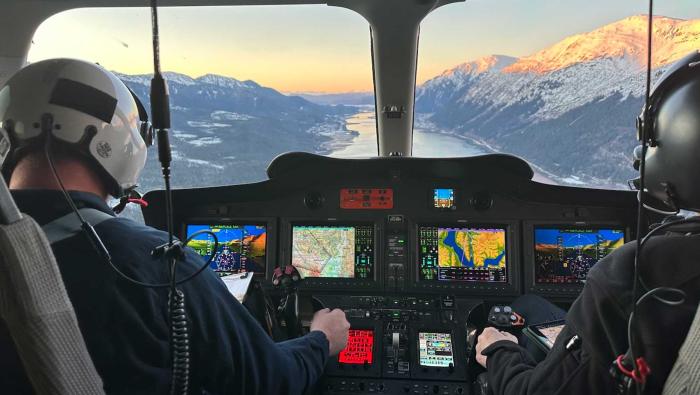|
Duncan Aviation has expanded its Garmin modernization program to include the Cessna Citation CJ1, offering operators an all-Garmin integrated avionics suite designed to improve flight deck capability and situational awareness. The package includes dual 10.6-inch or 12-inch Garmin G600 TXi flight displays, dual GTN 750Xi navigators (if not already installed), 7-inch TXi engine indication system display, GFC 600 digital autopilot, GMA 350 audio panel, and GI 275 standby instruments. Additionally, the system supports the optional GWX 8000 StormOptix weather radar and Garmin’s PlaneSync connected management platform. The CJ1 was recently added to Garmin’s approved model list supplemental type certificate, which already included the CJ2. Duncan said several of its facilities—including satellites in St. Paul, Minnesota, and Denver, Colorado—have completed the full Garmin modernization on other aircraft types such as the Pilatus PC-12, Beechcraft King Air 90/200, and Citation Excel/XLS. Corporate jet captain Michael Kussatz said the GFC 600 autopilot provides particular operational benefits when paired with the GTN Xi navigators: “They offer vertical navigation descents, fully coupled go-arounds, and Garmin’s Electronic Stability and Protection, which works in the background to nudge the aircraft back to a safe altitude during manual flight. It can fly a range of approaches and holds, build custom holds, and includes emergency descent mode.” Duncan said installations will take about eight weeks and can be scheduled at its main facilities or satellite locations. |
|
|
All pilots maintaining a first-class FAA medical certificate must periodically obtain a screening electrocardiogram (ECG). The initial screening ECG is done at age 35, then annually after 40. While most ECGs are done at the AME’s office at the time of exam, there are certain circumstances when an ECG done elsewhere may be acceptable to the AME and FAA if it can be verified that the ECG does represent the pilot in question. For those who are unsure of what I mean by ECG, they will quickly recognize the colloquially used, but outdated, EKG acronym. They are one and the same. This test screens for electrical activity in the heart. All cardiac muscle has some inherent conductivity, and there are also the primary bundle branches that conduct the electrical impulses to the various cardiac musculature. Pilots ask me whether the ECG is a good predictive tool for assessing future heart attack risks (myocardial infarction, or MI). While the ECG can give reasonable information to assess if the pilot has had an MI in the past, it is unfortunately not that great for future heart attack risk assessment. However, the ECG is still a great tool, and the pilot and their treating physician can outline the best risk-modification program for the pilot, considering family history, individual medical conditions, and the ECG itself. |
|
|
Argus International and AerLogics are joining forces to offer a combined safety rating that establishes a new standard, the companies announced today. Under the strategic collaboration, the companies will combine Argus’ Platinum and Platinum Elite air charter rating systems with AerLogics’ AerStar Performance Rating. The audit-based Argus ratings verify that operators have met high levels of safety, quality, and operational benchmarks. An operator must demonstrate a commitment to excellence and continuous improvement. AerLogics’ AerStar Performance Rating dives into safety monitoring. Under AerStar’s performance-based approach, real-time flight performance data is analyzed in context with key industry risk variables to provide actionable insights into how well operators are managing aircraft in-flight. The rating system is intended to provide a deeper understanding of operational behavior and risk mitigation. Combined, the ratings provide a comprehensive approach from preflight safety validation to real-time in-flight performance monitoring. “Bringing together the real-time monitoring of flight performance through the AerLogics AerStar rating and the Platinum and Platinum Elite audit brings forth a new level of understanding for passengers on jets,” said Argus president Mike McCready. “They can easily see what operators are performing the best in the industry.” AerLogics president Rob Handley added, “By combining our real-time AerStar Performance Rating insights with Argus’ trusted audit framework, we’re giving the industry a powerful tool to measure, understand, and improve operator performance like never before.” |
|
|
A new report from aircraft charter broker Victor and industry sustainability solutions provider 4Air highlights the impact private jet contrails can have on the environment. Contrails are formed by jet engine emissions interacting with the proper combination of humidity and temperature in the upper atmosphere. Depending on the location and time of day, long-lasting contrails can have an “outsized warming impact, trapping and absorbing heat that would otherwise radiate back into space.” Climatologists refer to the intensity of atmospheric warming in terms of effective radiative forcing (ERF), and according to a white paper from Contrails Org, the ERF from all aviation CO2 emissions from 1940 to 2019 is similar to the ERF caused by contrails alone in 2019. Victor’s debut “Contrails Report,” the first of its kind from a private jet charter broker, analyzed nearly 3,000 flights and found that just 1% of contrails accounted for 48% of aviation’s total warming impact of those flights. This demonstrates how a small number of high-impact contrails are disproportionately responsible for climate effects, and illustrates how change can be achieved by targeting specific flight profiles. “One misconception is that private jets fly above contrail regions; our report proves this isn’t always the case,” said Victor co-CEO Toby Edwards. |
|
|
Aero Star Aviation, a Dallas-based FAA repair station and Embraer maintenance specialist, has introduced an artificial intelligence (AI) tool to improve efficiency and customer experience. The system, featuring a virtual assistant named Ava (Aero Star virtual assistant), is designed to streamline troubleshooting for technicians and reduce maintenance turnaround times by accessing data captured in the Corridor MRO management software that Aero Star uses. “Artificial intelligence is something that is new, and it’s very powerful, and can impact new ways of doing things in aviation,” said Aero Star owner and president Chris Grinnell. An aircraft technician with years of experience working on Embraer business jets, Grinnell often finds himself dragged into questions of how to troubleshoot a problem that a newer mechanic has never seen before. “It’s all based off of tribal knowledge,” he said. Instead of hoping that the tribal knowledge will get passed along from himself and other experienced technicians, Grinnell wondered whether all the maintenance data captured in Corridor could inform an AI assistant that would help answer those questions. The result was Ava. “It’s accessing all of our data that we have combined over the years and it’s putting it at the access of the technicians’ fingertips,” he said. |
|
|
Serbian aircraft charter and maintenance company Prince Aviation is the first in Europe to renew its Wyvern Wingman Pro certification, the aviation risk management solution provider’s highest safety benchmark. Nearly three years ago, Prince—which operates a fleet of Cessna Citations and Dassault Falcons from its base at Belgrade Nikola Tesla Airport (LYBE)—received the Wyvern Level 4 safety management system (SMS) certificate, and was then certified under Wingman Pro, making it the first on the continent to receive that status. Wingman Pro is awarded to operators who demonstrate effectiveness in all areas of safety management systems, excel in addressing human factors and organizational safety culture, and maintain continuous conformity to international standards through an internal audit program. In addition to its charter operation, Prince, which celebrates its 35th anniversary this year, operates a maintenance division and a pilot training center. “We anticipate safety risks, set standards beyond legal minimums, innovate while maintaining compliance, and prioritize rigorous training for pilots and technical staff,” said Milica Djurdjevic, the company’s safety, compliance, and security manager. “Most importantly, we cultivate a company-wide safety culture where every employee is aligned toward our paramount goal: safety.” |
|
|
Garmin has added weather tools to its web-based flight planning platform to help pilots visualize and plan around adverse conditions. The enhancements include forecast visualizations that help pilots plan both VFR and IFR routes around challenging weather. Full-featured flight planning is available in North America at launch, and coverage for additional regions is planned for the future. Garmin Pilot Web, which complements the Garmin Pilot mobile app, provides access to high-resolution maps, charts, aeronautical data, airport information, and weather overlays. The new weather suite adds several forecast and analysis features, including Future Radar, allowing users to move a playback bar forward to preview precipitation and storm movement along a planned route. Additional overlays such as Storm Tops and Echo Tops display the altitude of thunderstorm activity and precipitation intensity, helping pilots assess whether to climb above or route around hazardous weather. The Surface Visibility feature provides forecast visibility at ground level, while Freezing Levels indicate the altitude at which icing conditions may occur. Garmin also added fuel and leg-distance readouts to Pilot Web’s route overlay. Thus, pilots can now view fuel required for each flight leg directly on the map. |
|
|
Omni Aviation Training Center (OATC) in Lisbon, Portugal, has partnered with Unlimited Aerobatics to provide advanced upset prevention and recovery training (A-UPRT) courses. The A-UPRT will be conducted in Unlimited Aerobatics’ Extra 300 piston single, which is certified to +/- 8 g. UPRT is mandatory for new commercial pilots in Europe, and this is the first time in Portugal that the advanced variant will be offered, according to OATC. The training is designed to help pilots with prevention by teaching them to recognize and correct upsets and avoid possible loss of control in flight (LOC-I). LOC-I remains the leading cause of airline accident fatalities. According to the company, the Unlimited Aerobatics course includes “theoretical knowledge and practical experience in unusual attitudes and stall recovery, expanding a pilot’s flight envelope by developing unique confidence in handling unexpected situations.” “OATC is setting a new standard in pilot training,” said Dylan van Haasen, head of training for Omni Aviation. “By partnering with Unlimited Aerobatics, we are delivering the most advanced and effective A-UPRT program in Portugal. We’re not here just to be regulatory compliant; our goal is to give students the best preparation possible to build confidence, resilience, and safety in the cockpit. Delivering this program together with Unlimited Aerobatics is a direct extension of that philosophy.” |
|
|
Top Stories This Week on AINonline |
|

Photo of the WeekRelentless in Alaska. The Bell 525 Relentless arrives at Juneau, Alaska, for icing and cold-weather trials under its flight-test campaign. Bell still hopes that the super-medium twin helicopter will receive FAA certification by year-end. Thanks to Bell engineer test pilot Barbara Lewis for sharing this one! Keep them coming. If you’d like to submit an entry for Photo of the Week, email a high-resolution horizontal image (at least 2000 x 1200 pixels), along with your name, contact information, social media names, and info about it (including brief description, location, etc.) to photos@ainonline.com. Tail numbers can be removed upon request. Those submitting photos give AIN implied consent to publish them in its publications and social media channels. |
|
|
|
|
AINalerts News Tips/Feedback: News tips may be sent anonymously, but feedback must include name and contact info (we will withhold name on request). We reserve the right to edit correspondence for length, clarity, and grammar. Send feedback or news tips to AINalerts editor Chad Trautvetter. |
|
AINalerts is a publication of AIN Media Group, 214 Franklin Avenue, Midland Park, New Jersey. Copyright 2025. All rights reserved. Reproduction in whole or in part without permission is strictly prohibited. |









.gif)
-Oct-10-2025-06-16-51-7745-PM.jpg?upscale=true&width=1396&upscale=true&name=Aircraft%20Post%20Business%20Market%20Recap%20Banner%20(v3)-Oct-10-2025-06-16-51-7745-PM.jpg)





